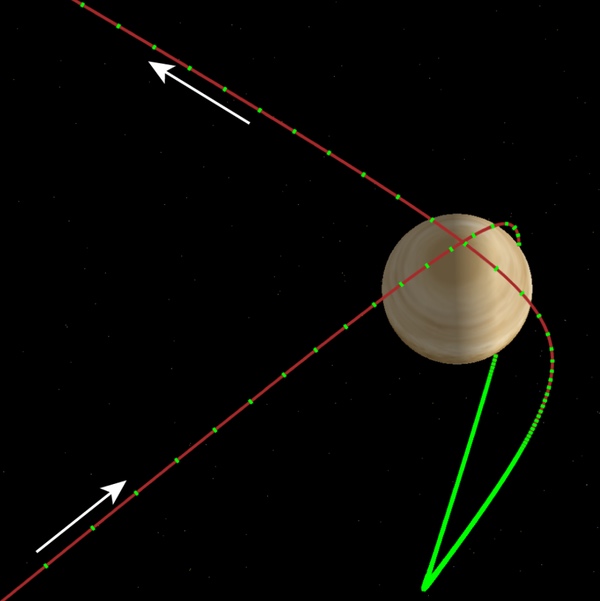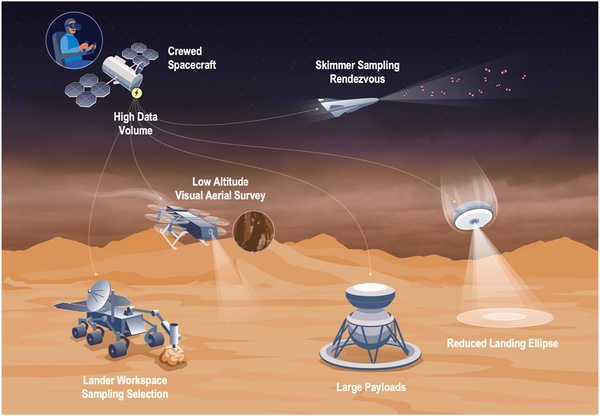To go to Mars, do a backflip at Venusby Jeff Foust
|
| A Venus mission, the report concluded, “affords the ability to close knowledge gaps and buttress confidence in technology, concept of operations, and human adaptability before setting out on a Mars expedition.” |
There are alternative concepts, though, for human spaceflight beyond Earth. SpaceX and its founder, Elon Musk, have advocated going directly to Mars with its Starship vehicle, getting there far earlier than NASA’s plans. But as Starship becomes increasingly tied to Artemis, it’s not clear how many resources SpaceX can devote to such visions while carrying out its NASA obligations.
Another concept seems, at first glance, like a diversion from human-to-Mars concepts. In the early years of the Space Age, engineers studied concepts for human flyby missions of Venus, but they fell out of favor as the focus turned to Mars. NASA’s new interest in “opposition-class” Mars missions, which limit the time at Mars to no more than a couple months, offers an opportunity to also conduct a Venus flyby on either the outbound or return legs of the mission.
Some, though, see a value of doing a Venus flyby mission as a precursor for going to Mars. A July 2022 workshop by Caltech’s Keck Institute for Space Studies, attracting participants from NASA, industry, and academia, focused on the science and exploration prospects for a Venus human flyby mission, leading to a report published in September.
A central argument to a human Venus mission is that it offers an intermediate stepping-stone between human missions to the Moon, lasting weeks or months, and a Mars mission with a round trip of as much as three years. “As part of an integrated strategy toward a first mission to Mars, a dedicated mission to Venus has the potential to be a productive and beneficial mission that could expand our human spaceflight operations knowledge in a stepwise manner starting at and around the Moon, continuing to Venus, and then at Mars,” the workshop report states.
Such a mission, lasting one to two years, would test out many of the technologies needed for a cruise to Mars and back, as well as the various human factors issues associated with missions far longer than expeditions in Earth orbit or at the Moon. A Venus mission, the report concluded, “affords the ability to close knowledge gaps and buttress confidence in technology, concept of operations, and human adaptability before setting out on a Mars expedition.”
The simplest mission would be a Venus flyby. One example of such a mission mentioned in the report would launch in August 2034 and return just over a year later, making a close approach to Venus in November 2034. The mission would spend 72 days in the vicinity of Venus, which the report defines as being within one light-minute of the planet: close enough to allow for teleoperation of probes in the planet’s atmosphere or on its surface.
A more complex option is to go into orbit around Venus. Another mission profile in the report offered a mission lasting just over two years, launching in July 2039 and returning in August 2041, spending 450 days in orbit around Venus.
Both concepts have tradeoffs. The flyby mission is straightforward and short, with no requirements for maneuvers after Earth departure. However, spending a relatively short time in the vicinity of Venus limits the scientific return from the mission, particularly when compared to other robotic missions in development for launch in the next decade.
“It would be a highly expensive venture, which would no doubt produce some amazing imagery and useful additional data,” wrote one critic, Andrew Coates of the Mullard Space Science Laboratory at University College London. “However, this would add little to the detailed and much longer bespoke studies currently planned.”
An orbiting mission would address the scientific return question by spending more than a year in orbit. However, the mission is more complex, with critical maneuvers required to enter and exit orbit around Venus. A similar Mars orbiting mission included in the report as a comparison would be somewhat longer—982 days—and require more delta-V, but would be closer to the goal of a human Mars landing.
The Keck workshop, though, found a middle ground between the flyby and the orbital Venus missions. That alternative, dubbed the “Venus Back-Flip” by workshop participants, would involve two flybys of Venus, with the mission staying close to Venus between the two. The first flyby would send the spacecraft out of the ecliptic, loitering over one of poles of the planet (from the perspective of Venus), before making a second flyby to go back to Earth. Such a maneuver, formally called a “pi transfer,” was used by Cassini to adjust its orbit around Saturn, but had not, to the recollection of workshop participants, ever been proposed for a crewed mission.
 An illustration from the report of the “Venus Back-Flip” maneuver that would allow a crewed mission to perform two close approaches to the planet, spending nearly six months in the vicinity of Venus. |
In the sample mission architecture included in the report, the mission would depart Earth in August 2034, making flybys of Venus in November 2034 and March 2035 before returning to Earth in February 2036. The mission would last a year and a half, with nearly six months spent in the one-light-minute vicinity of Venus. Like the flyby, though, the mission would not require any propulsive maneuvers after Earth departure.
“Thus, this presents an opportunity to be the first human interplanetary mission, set a new flight duration record, present longer time for science teleoperation, and gain valuable human health and performance knowledge for deep space all while on a free-return trajectory,” the report stated.
The report emphasized the scientific benefits of having humans in the vicinity of Venus, including the ability to teleoperate probes and make decisions in realtime. That could build upon upcoming robotic Venus missions by NASA, ESA, and others, it argued.
| “The combination of the intrinsic motivation of individuals and the potential signaling value for nation states or individuals suggests that once it is possible and practicable to achieve, someone will try to achieve it.” |
Perhaps the biggest challenge for a Venus crewed mission is finding public and political support for it. One chapter examines some steps for doing so, like advocacy organizations devoted to Venus—analogous to Mars-focused groups like The Mars Society—and arguments for doing so, from comparative planetology (what Venus can teach us about climate change on Earth) to a “cosmic paradigm shift” of seeing another planet up close to the first time.
A Venus flyby or orbital mission, the report argued, might be easier to sell than its Martian equivalent. “Some see it as politically and popularly untenable to have a first human Mars mission that does not land—in other words, if humans are going to Mars, the public will want them to land,” it stated. That is not an issue for Venus, where a human landing is not feasible for the indefinite future. “This makes planning and designing such a mission potentially simpler and cheaper while still maintaining high public engagement and interest.”
A Venus flyby mission could be a “shakedown cruise” for the habitat intended for going to Mars (presumably with some modifications to account for a different thermal environment, for example), offering a test of that system before going on a longer mission to Mars. However, the report acknowledges NASA won’t decide for some time what kind of shakedown cruise, if any, it will conduct for a Mars vehicle.
Venus mission advocates face an uphill climb, for now, to get a crewed Venus mission into NASA’s plans, something the workshop organizers acknowledge in the report. “Human missions to Venus are not part of the baseline exploration architecture of NASA or any other organization that participated in the symposium. Missions to Venus are not part of NASA’s current Moon to Mars Objectives,” it stated.
Those objectives, though, are still relatively new, rolled out last May with an updated version in September at the International Astronautical Congress in Paris—the same conference where some Venus workshop participants discussed their new report. That study hasn’t gotten much attention since then, but it does present an option for NASA mission planners to consider as they start to add details to their frameworks for getting humans to Mars.
The report hints at one other rationale that might garner more support, or at least a different kind of support, than just science and preparing for human Mars exploration. “As with any major space exploration achievement, there is a potential signaling value to be claimed by anyone who accomplishes a first human mission to Venus,” it stated. “The combination of the intrinsic motivation of individuals and the potential signaling value for nation states or individuals suggests that once it is possible and practicable to achieve, someone will try to achieve it.”
Note: we are using a new commenting system, which may require you to create a new account.
